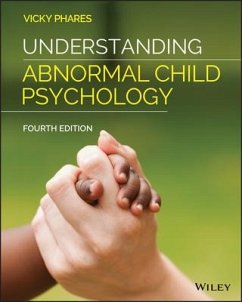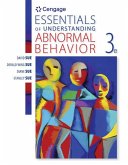Vicky Phares (University of South Florida)
Understanding Abnormal Child Psychology
Vicky Phares (University of South Florida)
Understanding Abnormal Child Psychology
- Broschiertes Buch
Andere Kunden interessierten sich auch für
![Case Studies in Abnormal Psychology Case Studies in Abnormal Psychology]() Thomas F. Oltmanns (University of Virginia)Case Studies in Abnormal Psychology156,99 €
Thomas F. Oltmanns (University of Virginia)Case Studies in Abnormal Psychology156,99 €![The True Believer The True Believer]() Eric HofferThe True Believer16,99 €
Eric HofferThe True Believer16,99 €![Abnormal Psychology Abnormal Psychology]() V. Durand (St. Petersburg University of South Florida)Abnormal Psychology92,99 €
V. Durand (St. Petersburg University of South Florida)Abnormal Psychology92,99 €![Abnormal Psychology and Life Abnormal Psychology and Life]() Chris Kearney (Las Vegas University of Nevada)Abnormal Psychology and Life106,99 €
Chris Kearney (Las Vegas University of Nevada)Abnormal Psychology and Life106,99 €![ABNORMAL PSYCHOLOGY GLOBAL EDITION ABNORMAL PSYCHOLOGY GLOBAL EDITION]() JAMES N. BUTCHERABNORMAL PSYCHOLOGY GLOBAL EDITION99,99 €
JAMES N. BUTCHERABNORMAL PSYCHOLOGY GLOBAL EDITION99,99 €![Essentials of Understanding Abnormal Behavior Essentials of Understanding Abnormal Behavior]() David Sue (Western Washington University)Essentials of Understanding Abnormal Behavior264,99 €
David Sue (Western Washington University)Essentials of Understanding Abnormal Behavior264,99 €![Essentials of Abnormal Psychology Essentials of Abnormal Psychology]() V. Durand (St. Petersburg University of South Florida)Essentials of Abnormal Psychology104,99 €
V. Durand (St. Petersburg University of South Florida)Essentials of Abnormal Psychology104,99 €-
-
-
Produktdetails
- Verlag: John Wiley & Sons Inc
- 4 ed
- Seitenzahl: 688
- Erscheinungstermin: 9. September 2020
- Englisch
- Abmessung: 254mm x 206mm x 23mm
- Gewicht: 1200g
- ISBN-13: 9781119605287
- ISBN-10: 1119605288
- Artikelnr.: 60579978
Hinweis: Dieser Artikel kann nur an eine deutsche Lieferadresse ausgeliefert werden.
- Herstellerkennzeichnung
- Libri GmbH
- Europaallee 1
- 36244 Bad Hersfeld
- gpsr@libri.de
Vicky Phares is a professor of psychology at the University of South Florida. Her research looks at a variety of issues related to child, adolescent, and family functioning with particular interest in exploring the connections between psychopathology in fathers, mothers, and children, and on gender in relation to parenting, particularly as relates to anxious youth. Projects include the exploration of fathers' and mothers' involvement in therapy, mother-blaming, and racial/ethnic differences and similarities in families. She is currently exploring connections between parents' and children's prosocial behavior, with a specific focus on volunteerism.
Preface xix
Acknowledgments xxv
1 Conceptualizations of Normality and Abnormality in Children and
Adolescents 1
Normality and Abnormality in Children and Adolescents 1
History of Understanding Abnormal Child Behavior 4
More Recent Diagnostic Classifi cation Systems 8
Reliability and Validity of Diagnostic Categories 13
Children in the School System 14
Disorders in the Future of DSM 17
Advantages and Disadvantages of the DSM-5 19
Diff erences between Categorical and Dimensional Understanding of Behavior
21
Prevalence of Children's and Adolescents' Problem Behavior 25
Epidemiological Rates Based on the Categorical Approach 25
Epidemiological Rates Based on the Dimensional Approach 28
How Children's Environments Infl uence Their Behavior 30
Diff erent Perspectives on Problems 32
Troubled Families Rather Than Troubled Children 33
Summary and Key Concepts 34
Key Terms 36
Study Questions 36
Suggested Readings 36
Suggested Viewings 37
2 Theories of Normality and Abnormality in Children and Adolescents 38
The Importance of Theory 41
Psychodynamic Theory 42
Genetic and Biological Theories of Developmental Psychopathology 46
Behavioral Genetics 50
Behavioral Theories and Developmental Psychopathology 51
Cognitive Behavioral Theories and Developmental Psychopathology 52
Theories of Family Functioning and Abnormal Behavior in Children and
Adolescents 54
The Influence of Social Context on the Development and Maintenance of
Problem Behavior 56
The Overarching Theory of Developmental Psychopathology 62
Summary and Key Concepts 65
Key Terms 67
Study Questions 67
Suggested Readings 67
Suggested Viewings 68
3 Research Methods in the Study of Developmental Psychopathology 69
Research Methodologies That Are Utilized in the Study of Developmental
Psychopathology 72
Experimental Designs 72
Quasi-Experimental Designs 74
Correlational Designs 75
Case Studies and Single-Subject Designs 75
High-Risk Designs 77
Behavioral Genetics Designs 77
Time Frame of the Research Study 78
Cross-Sectional Research 78
Prospective Longitudinal Research 79
Accelerated Longitudinal Research 81
The Actual Process of Research 81
Choosing a Research Topic and Identifying Hypotheses 82
Choosing a Sample 83
Choosing Psychometrically Sound Measures 84
Collecting Data 84
Data Analyses 86
Writing Up, Presenting, and Publishing the Results 87
Continuing the Research Process 88
Choosing Appropriate Samples of Participants 89
Quantitative Research and Qualitative Research 92
Areas in Need of Further Study in Developmental Psychopathology 92
Ethics of Conducting Research 93
Summary and Key Concepts 96
Key Terms 98
Study Questions 98
Suggested Readings 98
Suggested Viewings 98
4 Assessment and Therapeutic Interventions with Children, Adolescents, and
Families 99
Assessments 99
Multiaxial Assessment of Children and Adolescents 102
Interviews with Children and Their Parents 102
Unstructured Interviews 103
Semistructured Interviews 104
Structured Interviews 107
Behavioral Assessment 107
Behavioral Observation 108
Functional Assessment 108
Self-Monitoring 109
Checklists and Rating Scales 110
Broad Measures 110
Measures of Competence and Adaptive Functioning 114
Personality Assessment 115
Personality Inventories 115
Projective Measures 116
Family Assessment 116
Assessing Intellectual Functioning and Academic Achievement 119
Educational Assessment 121
Neuropsychological Assessment 122
Therapeutic Interventions 123
Settings Where Interventions Are Conducted 124
Psychodynamic Therapies 126
Behavioral Therapies 128
Child-Oriented Interventions 128
Parent-Oriented Interventions 128
Cognitive Behavioral Therapies 131
Family Systems Therapies 132
Psychopharmacological Interventions 135
Effectiveness of Therapeutic Interventions 139
Prevention Programs that Work 142
Professional Ethics in Assessment and Interventions 146
Competence 146
Multiple Relationships 147
Informed Consent 148
Confidentiality 149
Summary and Key Concepts 151
Key Terms 154
Study Questions 154
Suggested Readings 154
Suggested Viewings 155
5 Risk Factors and Issues of Prevention 156
Temperament 157
Attachment 158
Genetic Predisposition 159
Parental Psychopathology 160
Parental Loss due to Death 162
Interparental Conflict 163
Child Physical Abuse 166
Child Sexual Abuse 169
Child Psychological Maltreatment 173
Inadequate Educational Resources 175
Poverty and Low Socioeconomic Status 177
Violence within the Community 180
Cumulative Risk Exposure 183
Summary and Key Concepts 184
Key Terms 185
Study Questions 185
Suggested Readings 186
Suggested Viewings 186
6 Protective Factors and Issues of Prevention 187
Characteristics within the Child 188
Adaptable Temperament 188
Effective Emotional and Behavioral Regulation Strategies 190
Good Cognitive Abilities 191
Positive View of Self (Self-Confidence High Self-Esteem and Self-Efficacy)
191
Other Protective Characteristics within the Child 193
Characteristics within the Family 193
Stable and Supportive Home Environment 194
Faith and Religious Affiliations 198
Other Protective Characteristics within the Family 199
Characteristics within the Community 200
Connections to Caring Adult Mentors and Prosocial Peers 200
High Neighborhood Quality 202
Effective Schools 202
Other Protective Factors within the Community 205
Characteristics within the Culture or Society 205
Summary and Key Concepts 206
Key Terms 207
Study Questions 207
Suggested Readings 208
Suggested Viewings 208
7 Depressive Disorders, Bipolar Disorders, and Related Problems 209
Anaclitic Depression and Failure to Thrive in Infancy 209
Masked Depression 210
Major Depressive Disorder 210
Prevalence Rates 213
Comorbidity 216
Course of the Disorder 217
Etiology 218
Treatment 222
Prevention 226
Child and Adolescent Suicide 228
Bipolar Disorder 235
Depression Conceptualized in a Dimensional Manner 240
Risk Factors 242
Protective Factors 244
Summary and Key Concepts 246
Key Terms 247
Study Questions 248
Suggested Readings 248
Suggested Viewings 248
8 Anxiety Disorders, Obsessive-Compulsive and Related Disorders, and
Trauma- and Stressor-Related Disorders and Problems 249
Separation Anxiety Disorder 251
Prevalence Rates 253
Selective Mutism 253
Prevalence Rates 253
Specific Phobia 254
Prevalence Rates 256
Social Anxiety Disorder 257
Prevalence Rates 258
Generalized Anxiety Disorder 259
Prevalence Rates 259
Obsessive-Compulsive Disorder 260
Prevalence Rates 262
Hoarding Disorder 263
Posttraumatic Stress Disorder 265
Prevalence Rates 267
Adjustment Disorder 267
All Anxiety Disorders, Obsessive-Compulsive and Related Disorders, and
Trauma- and Stressor-Related Disorders of Childhood and Adolescence 268
Comorbidity 269
Course of the Disorder 269
Etiology 270
Treatment 274
Prevention 279
Anxiety Conceptualized in a Dimensional Manner 282
Risk Factors 283
Protective Factors 284
Summary and Key Concepts 285
Key Terms 287
Study Questions 287
Suggested Readings 287
Suggested Viewings 287
9 Attention-Deficit/Hyperactivity Disorder and Related Problems 288
Attention-Deficit/Hyperactivity Disorder 288
Prevalence Rates 294
Comorbidity 298
Course of the Disorder 302
Etiology 304
Treatment 309
Prevention 318
Attention-Deficit/Hyperactivity Disorder Conceptualized in a Dimensional
Manner 319
Risk Factors 319
Protective Factors 322
Summary and Key Concepts 322
Key Terms 323
Study Questions 323
Suggested Readings 323
Suggested Viewings 324
10 Disruptive and Conduct Disorders and Related Problems 325
Oppositional Defiant Disorder 325
Prevalence Rates 328
Conduct Disorder 329
Prevalence Rates 332
Antisocial Personality Disorder 333
Oppositional Defiant Disorder and Conduct Disorder 334
Comorbidity 335
Courses of the Disorders 336
Etiology 339
Treatment 344
Prevention 349
Oppositional Problems and Conduct Problems Conceptualized in a Dimensional
Manner 351
Risk Factors 352
Protective Factors 354
Summary and Key Concepts 355
Key Terms 356
Study Questions 356
Suggested Readings 357
Suggested Viewings 357
11 Alcohol and Substance Use Disorders and Problems 358
Alcohol and Substance Use Disorders 358
Prevalence Rates 361
Comorbidity 365
Course of the Disorder 366
Etiology 367
Treatment 371
Prevention 376
Alcohol and Substance Use Conceptualized in a Dimensional Manner 379
Risk Factors 381
Protective Factors 384
Nicotine 385
Summary and Key Concepts 387
Key Terms 388
Study Questions 388
Suggested Readings 388
Suggested Viewings 388
12 Autism Spectrum Disorder and Schizophrenia 389
Autism Spectrum Disorder 389
Prevalence Rates 395
Comorbidity 396
Course of the Disorder 398
Etiology 401
Treatment 402
Prevention 405
Autism Spectrum Disorder Conceptualized in a Dimensional Manner 406
Risk Factors 407
Protective Factors 407
Schizophrenia 408
Prevalence Rates 409
Comorbidity 409
Course of the Disorder 410
Etiology 410
Treatment 412
Prevention 413
Schizophrenia Conceptualized in a Dimensional Manner 414
Risk Factors 414
Protective Factors 415
Summary and Key Concepts 415
Key Terms 416
Study Questions 416
Suggested Readings 417
Suggested Viewings 417
13 Specific Learning Disorders and Intellectual Disability 418
Specific Learning Disorders 419
Prevalence Rates 422
Comorbidity 424
Course of the Disorder 426
Etiology 427
Treatment 430
Prevention 434
Specific Learning Disorders and Learning Problems Conceptualized in a
Dimensional Manner 435
Risk Factors 436
Protective Factors 437
Intellectual Disability 441
Prevalence Rates 444
Comorbidity 445
Course of the Disorder 447
Etiology 449
Treatment 451
Prevention 452
Intellectual Disability Conceptualized in a Dimensional Manner 454
Risk Factors 455
Protective Factors 455
Summary and Key Concepts 456
Key Terms 457
Study Questions 457
Suggested Readings 458
Suggested Viewings 458
14 Pediatric Psychology and Health Psychology for Children and Adolescents
459
Pediatric Psychology 459
Eating Disorders and Obesity 461
Anorexia Nervosa 462
Bulimia Nervosa 463
Comorbidity of Eating Disorders 465
Course of the Disorders 466
Etiology of Eating Disorders 466
Treatment of Eating Disorders 467
Prevention of Eating Disorders 468
Dimensional Conceptualizations of Body Image Problems 469
Obesity 470
Elimination Disorders 475
Enuresis 475
Encopresis 478
Dimensional Conceptualizations of Elimination Disorders 480
Chronic Illness in Children and Children's Well-Being 480
Juvenile-Onset Diabetes 481
Sickle Cell Disease 482
Childhood Cancer 484
HIV/AIDS in Children and Adolescents 486
Chronic Illness in Parents and Children's Well-Being 489
Parental Cancer 489
Parental HIV/AIDS 490
Treatment Issues in Pediatric Psychology 491
Prevention Issues in Pediatric Psychology 492
Summary and Key Concepts 494
Key Terms 495
Study Questions 495
Suggested Readings 496
Suggested Viewings 496
15 Ways to Help Children 497
How Nonprofessionals and Paraprofessionals Can Help Children 497
Transitioning from a Paraprofessional to a Professional 500
How Having a Career in Psychology Can Help Children 502
Ph.D. or Master's in Clinical Psychology 503
Psy.D. in Clinical Psychology 510
Ph.D. in Experimental Psychopathology 511
Ph.D. Ed.D. or Master's in Counseling Psychology 511
Ph.D. or Master's in Developmental Psychology 512
How Having a Career in Social Work Can Help Children 512
Bachelor's of Social Work 512
Master's of Social Work 513
Doctorate of Social Work 513
How Having a Career in Education Can Help Children 513
Teachers 513
Special Education Teachers 514
Guidance Counselors 514
School Psychologists and Educational Specialists 514
Other Professionals 515
How Having a Career in Medicine Can Help Children 515
Psychiatric Nurses 515
Psychiatrists 516
Developmental Pediatricians 517
Other Professionals 518
How Having a Career in the Judicial Justice System Can Help Children 519
School Resource Officers 519
Criminologists 520
Forensic Psychologists 520
Attorneys and Judges 520
How Having a Career in Prevention Can Help Children 521
Summary and Key Concepts 521
Key Terms 522
Study Questions 523
Suggested Readings 523
Suggested Viewings 523
References R-1
Glossary G-1
Index I-1
Acknowledgments xxv
1 Conceptualizations of Normality and Abnormality in Children and
Adolescents 1
Normality and Abnormality in Children and Adolescents 1
History of Understanding Abnormal Child Behavior 4
More Recent Diagnostic Classifi cation Systems 8
Reliability and Validity of Diagnostic Categories 13
Children in the School System 14
Disorders in the Future of DSM 17
Advantages and Disadvantages of the DSM-5 19
Diff erences between Categorical and Dimensional Understanding of Behavior
21
Prevalence of Children's and Adolescents' Problem Behavior 25
Epidemiological Rates Based on the Categorical Approach 25
Epidemiological Rates Based on the Dimensional Approach 28
How Children's Environments Infl uence Their Behavior 30
Diff erent Perspectives on Problems 32
Troubled Families Rather Than Troubled Children 33
Summary and Key Concepts 34
Key Terms 36
Study Questions 36
Suggested Readings 36
Suggested Viewings 37
2 Theories of Normality and Abnormality in Children and Adolescents 38
The Importance of Theory 41
Psychodynamic Theory 42
Genetic and Biological Theories of Developmental Psychopathology 46
Behavioral Genetics 50
Behavioral Theories and Developmental Psychopathology 51
Cognitive Behavioral Theories and Developmental Psychopathology 52
Theories of Family Functioning and Abnormal Behavior in Children and
Adolescents 54
The Influence of Social Context on the Development and Maintenance of
Problem Behavior 56
The Overarching Theory of Developmental Psychopathology 62
Summary and Key Concepts 65
Key Terms 67
Study Questions 67
Suggested Readings 67
Suggested Viewings 68
3 Research Methods in the Study of Developmental Psychopathology 69
Research Methodologies That Are Utilized in the Study of Developmental
Psychopathology 72
Experimental Designs 72
Quasi-Experimental Designs 74
Correlational Designs 75
Case Studies and Single-Subject Designs 75
High-Risk Designs 77
Behavioral Genetics Designs 77
Time Frame of the Research Study 78
Cross-Sectional Research 78
Prospective Longitudinal Research 79
Accelerated Longitudinal Research 81
The Actual Process of Research 81
Choosing a Research Topic and Identifying Hypotheses 82
Choosing a Sample 83
Choosing Psychometrically Sound Measures 84
Collecting Data 84
Data Analyses 86
Writing Up, Presenting, and Publishing the Results 87
Continuing the Research Process 88
Choosing Appropriate Samples of Participants 89
Quantitative Research and Qualitative Research 92
Areas in Need of Further Study in Developmental Psychopathology 92
Ethics of Conducting Research 93
Summary and Key Concepts 96
Key Terms 98
Study Questions 98
Suggested Readings 98
Suggested Viewings 98
4 Assessment and Therapeutic Interventions with Children, Adolescents, and
Families 99
Assessments 99
Multiaxial Assessment of Children and Adolescents 102
Interviews with Children and Their Parents 102
Unstructured Interviews 103
Semistructured Interviews 104
Structured Interviews 107
Behavioral Assessment 107
Behavioral Observation 108
Functional Assessment 108
Self-Monitoring 109
Checklists and Rating Scales 110
Broad Measures 110
Measures of Competence and Adaptive Functioning 114
Personality Assessment 115
Personality Inventories 115
Projective Measures 116
Family Assessment 116
Assessing Intellectual Functioning and Academic Achievement 119
Educational Assessment 121
Neuropsychological Assessment 122
Therapeutic Interventions 123
Settings Where Interventions Are Conducted 124
Psychodynamic Therapies 126
Behavioral Therapies 128
Child-Oriented Interventions 128
Parent-Oriented Interventions 128
Cognitive Behavioral Therapies 131
Family Systems Therapies 132
Psychopharmacological Interventions 135
Effectiveness of Therapeutic Interventions 139
Prevention Programs that Work 142
Professional Ethics in Assessment and Interventions 146
Competence 146
Multiple Relationships 147
Informed Consent 148
Confidentiality 149
Summary and Key Concepts 151
Key Terms 154
Study Questions 154
Suggested Readings 154
Suggested Viewings 155
5 Risk Factors and Issues of Prevention 156
Temperament 157
Attachment 158
Genetic Predisposition 159
Parental Psychopathology 160
Parental Loss due to Death 162
Interparental Conflict 163
Child Physical Abuse 166
Child Sexual Abuse 169
Child Psychological Maltreatment 173
Inadequate Educational Resources 175
Poverty and Low Socioeconomic Status 177
Violence within the Community 180
Cumulative Risk Exposure 183
Summary and Key Concepts 184
Key Terms 185
Study Questions 185
Suggested Readings 186
Suggested Viewings 186
6 Protective Factors and Issues of Prevention 187
Characteristics within the Child 188
Adaptable Temperament 188
Effective Emotional and Behavioral Regulation Strategies 190
Good Cognitive Abilities 191
Positive View of Self (Self-Confidence High Self-Esteem and Self-Efficacy)
191
Other Protective Characteristics within the Child 193
Characteristics within the Family 193
Stable and Supportive Home Environment 194
Faith and Religious Affiliations 198
Other Protective Characteristics within the Family 199
Characteristics within the Community 200
Connections to Caring Adult Mentors and Prosocial Peers 200
High Neighborhood Quality 202
Effective Schools 202
Other Protective Factors within the Community 205
Characteristics within the Culture or Society 205
Summary and Key Concepts 206
Key Terms 207
Study Questions 207
Suggested Readings 208
Suggested Viewings 208
7 Depressive Disorders, Bipolar Disorders, and Related Problems 209
Anaclitic Depression and Failure to Thrive in Infancy 209
Masked Depression 210
Major Depressive Disorder 210
Prevalence Rates 213
Comorbidity 216
Course of the Disorder 217
Etiology 218
Treatment 222
Prevention 226
Child and Adolescent Suicide 228
Bipolar Disorder 235
Depression Conceptualized in a Dimensional Manner 240
Risk Factors 242
Protective Factors 244
Summary and Key Concepts 246
Key Terms 247
Study Questions 248
Suggested Readings 248
Suggested Viewings 248
8 Anxiety Disorders, Obsessive-Compulsive and Related Disorders, and
Trauma- and Stressor-Related Disorders and Problems 249
Separation Anxiety Disorder 251
Prevalence Rates 253
Selective Mutism 253
Prevalence Rates 253
Specific Phobia 254
Prevalence Rates 256
Social Anxiety Disorder 257
Prevalence Rates 258
Generalized Anxiety Disorder 259
Prevalence Rates 259
Obsessive-Compulsive Disorder 260
Prevalence Rates 262
Hoarding Disorder 263
Posttraumatic Stress Disorder 265
Prevalence Rates 267
Adjustment Disorder 267
All Anxiety Disorders, Obsessive-Compulsive and Related Disorders, and
Trauma- and Stressor-Related Disorders of Childhood and Adolescence 268
Comorbidity 269
Course of the Disorder 269
Etiology 270
Treatment 274
Prevention 279
Anxiety Conceptualized in a Dimensional Manner 282
Risk Factors 283
Protective Factors 284
Summary and Key Concepts 285
Key Terms 287
Study Questions 287
Suggested Readings 287
Suggested Viewings 287
9 Attention-Deficit/Hyperactivity Disorder and Related Problems 288
Attention-Deficit/Hyperactivity Disorder 288
Prevalence Rates 294
Comorbidity 298
Course of the Disorder 302
Etiology 304
Treatment 309
Prevention 318
Attention-Deficit/Hyperactivity Disorder Conceptualized in a Dimensional
Manner 319
Risk Factors 319
Protective Factors 322
Summary and Key Concepts 322
Key Terms 323
Study Questions 323
Suggested Readings 323
Suggested Viewings 324
10 Disruptive and Conduct Disorders and Related Problems 325
Oppositional Defiant Disorder 325
Prevalence Rates 328
Conduct Disorder 329
Prevalence Rates 332
Antisocial Personality Disorder 333
Oppositional Defiant Disorder and Conduct Disorder 334
Comorbidity 335
Courses of the Disorders 336
Etiology 339
Treatment 344
Prevention 349
Oppositional Problems and Conduct Problems Conceptualized in a Dimensional
Manner 351
Risk Factors 352
Protective Factors 354
Summary and Key Concepts 355
Key Terms 356
Study Questions 356
Suggested Readings 357
Suggested Viewings 357
11 Alcohol and Substance Use Disorders and Problems 358
Alcohol and Substance Use Disorders 358
Prevalence Rates 361
Comorbidity 365
Course of the Disorder 366
Etiology 367
Treatment 371
Prevention 376
Alcohol and Substance Use Conceptualized in a Dimensional Manner 379
Risk Factors 381
Protective Factors 384
Nicotine 385
Summary and Key Concepts 387
Key Terms 388
Study Questions 388
Suggested Readings 388
Suggested Viewings 388
12 Autism Spectrum Disorder and Schizophrenia 389
Autism Spectrum Disorder 389
Prevalence Rates 395
Comorbidity 396
Course of the Disorder 398
Etiology 401
Treatment 402
Prevention 405
Autism Spectrum Disorder Conceptualized in a Dimensional Manner 406
Risk Factors 407
Protective Factors 407
Schizophrenia 408
Prevalence Rates 409
Comorbidity 409
Course of the Disorder 410
Etiology 410
Treatment 412
Prevention 413
Schizophrenia Conceptualized in a Dimensional Manner 414
Risk Factors 414
Protective Factors 415
Summary and Key Concepts 415
Key Terms 416
Study Questions 416
Suggested Readings 417
Suggested Viewings 417
13 Specific Learning Disorders and Intellectual Disability 418
Specific Learning Disorders 419
Prevalence Rates 422
Comorbidity 424
Course of the Disorder 426
Etiology 427
Treatment 430
Prevention 434
Specific Learning Disorders and Learning Problems Conceptualized in a
Dimensional Manner 435
Risk Factors 436
Protective Factors 437
Intellectual Disability 441
Prevalence Rates 444
Comorbidity 445
Course of the Disorder 447
Etiology 449
Treatment 451
Prevention 452
Intellectual Disability Conceptualized in a Dimensional Manner 454
Risk Factors 455
Protective Factors 455
Summary and Key Concepts 456
Key Terms 457
Study Questions 457
Suggested Readings 458
Suggested Viewings 458
14 Pediatric Psychology and Health Psychology for Children and Adolescents
459
Pediatric Psychology 459
Eating Disorders and Obesity 461
Anorexia Nervosa 462
Bulimia Nervosa 463
Comorbidity of Eating Disorders 465
Course of the Disorders 466
Etiology of Eating Disorders 466
Treatment of Eating Disorders 467
Prevention of Eating Disorders 468
Dimensional Conceptualizations of Body Image Problems 469
Obesity 470
Elimination Disorders 475
Enuresis 475
Encopresis 478
Dimensional Conceptualizations of Elimination Disorders 480
Chronic Illness in Children and Children's Well-Being 480
Juvenile-Onset Diabetes 481
Sickle Cell Disease 482
Childhood Cancer 484
HIV/AIDS in Children and Adolescents 486
Chronic Illness in Parents and Children's Well-Being 489
Parental Cancer 489
Parental HIV/AIDS 490
Treatment Issues in Pediatric Psychology 491
Prevention Issues in Pediatric Psychology 492
Summary and Key Concepts 494
Key Terms 495
Study Questions 495
Suggested Readings 496
Suggested Viewings 496
15 Ways to Help Children 497
How Nonprofessionals and Paraprofessionals Can Help Children 497
Transitioning from a Paraprofessional to a Professional 500
How Having a Career in Psychology Can Help Children 502
Ph.D. or Master's in Clinical Psychology 503
Psy.D. in Clinical Psychology 510
Ph.D. in Experimental Psychopathology 511
Ph.D. Ed.D. or Master's in Counseling Psychology 511
Ph.D. or Master's in Developmental Psychology 512
How Having a Career in Social Work Can Help Children 512
Bachelor's of Social Work 512
Master's of Social Work 513
Doctorate of Social Work 513
How Having a Career in Education Can Help Children 513
Teachers 513
Special Education Teachers 514
Guidance Counselors 514
School Psychologists and Educational Specialists 514
Other Professionals 515
How Having a Career in Medicine Can Help Children 515
Psychiatric Nurses 515
Psychiatrists 516
Developmental Pediatricians 517
Other Professionals 518
How Having a Career in the Judicial Justice System Can Help Children 519
School Resource Officers 519
Criminologists 520
Forensic Psychologists 520
Attorneys and Judges 520
How Having a Career in Prevention Can Help Children 521
Summary and Key Concepts 521
Key Terms 522
Study Questions 523
Suggested Readings 523
Suggested Viewings 523
References R-1
Glossary G-1
Index I-1
Preface xix
Acknowledgments xxv
1 Conceptualizations of Normality and Abnormality in Children and
Adolescents 1
Normality and Abnormality in Children and Adolescents 1
History of Understanding Abnormal Child Behavior 4
More Recent Diagnostic Classifi cation Systems 8
Reliability and Validity of Diagnostic Categories 13
Children in the School System 14
Disorders in the Future of DSM 17
Advantages and Disadvantages of the DSM-5 19
Diff erences between Categorical and Dimensional Understanding of Behavior
21
Prevalence of Children's and Adolescents' Problem Behavior 25
Epidemiological Rates Based on the Categorical Approach 25
Epidemiological Rates Based on the Dimensional Approach 28
How Children's Environments Infl uence Their Behavior 30
Diff erent Perspectives on Problems 32
Troubled Families Rather Than Troubled Children 33
Summary and Key Concepts 34
Key Terms 36
Study Questions 36
Suggested Readings 36
Suggested Viewings 37
2 Theories of Normality and Abnormality in Children and Adolescents 38
The Importance of Theory 41
Psychodynamic Theory 42
Genetic and Biological Theories of Developmental Psychopathology 46
Behavioral Genetics 50
Behavioral Theories and Developmental Psychopathology 51
Cognitive Behavioral Theories and Developmental Psychopathology 52
Theories of Family Functioning and Abnormal Behavior in Children and
Adolescents 54
The Influence of Social Context on the Development and Maintenance of
Problem Behavior 56
The Overarching Theory of Developmental Psychopathology 62
Summary and Key Concepts 65
Key Terms 67
Study Questions 67
Suggested Readings 67
Suggested Viewings 68
3 Research Methods in the Study of Developmental Psychopathology 69
Research Methodologies That Are Utilized in the Study of Developmental
Psychopathology 72
Experimental Designs 72
Quasi-Experimental Designs 74
Correlational Designs 75
Case Studies and Single-Subject Designs 75
High-Risk Designs 77
Behavioral Genetics Designs 77
Time Frame of the Research Study 78
Cross-Sectional Research 78
Prospective Longitudinal Research 79
Accelerated Longitudinal Research 81
The Actual Process of Research 81
Choosing a Research Topic and Identifying Hypotheses 82
Choosing a Sample 83
Choosing Psychometrically Sound Measures 84
Collecting Data 84
Data Analyses 86
Writing Up, Presenting, and Publishing the Results 87
Continuing the Research Process 88
Choosing Appropriate Samples of Participants 89
Quantitative Research and Qualitative Research 92
Areas in Need of Further Study in Developmental Psychopathology 92
Ethics of Conducting Research 93
Summary and Key Concepts 96
Key Terms 98
Study Questions 98
Suggested Readings 98
Suggested Viewings 98
4 Assessment and Therapeutic Interventions with Children, Adolescents, and
Families 99
Assessments 99
Multiaxial Assessment of Children and Adolescents 102
Interviews with Children and Their Parents 102
Unstructured Interviews 103
Semistructured Interviews 104
Structured Interviews 107
Behavioral Assessment 107
Behavioral Observation 108
Functional Assessment 108
Self-Monitoring 109
Checklists and Rating Scales 110
Broad Measures 110
Measures of Competence and Adaptive Functioning 114
Personality Assessment 115
Personality Inventories 115
Projective Measures 116
Family Assessment 116
Assessing Intellectual Functioning and Academic Achievement 119
Educational Assessment 121
Neuropsychological Assessment 122
Therapeutic Interventions 123
Settings Where Interventions Are Conducted 124
Psychodynamic Therapies 126
Behavioral Therapies 128
Child-Oriented Interventions 128
Parent-Oriented Interventions 128
Cognitive Behavioral Therapies 131
Family Systems Therapies 132
Psychopharmacological Interventions 135
Effectiveness of Therapeutic Interventions 139
Prevention Programs that Work 142
Professional Ethics in Assessment and Interventions 146
Competence 146
Multiple Relationships 147
Informed Consent 148
Confidentiality 149
Summary and Key Concepts 151
Key Terms 154
Study Questions 154
Suggested Readings 154
Suggested Viewings 155
5 Risk Factors and Issues of Prevention 156
Temperament 157
Attachment 158
Genetic Predisposition 159
Parental Psychopathology 160
Parental Loss due to Death 162
Interparental Conflict 163
Child Physical Abuse 166
Child Sexual Abuse 169
Child Psychological Maltreatment 173
Inadequate Educational Resources 175
Poverty and Low Socioeconomic Status 177
Violence within the Community 180
Cumulative Risk Exposure 183
Summary and Key Concepts 184
Key Terms 185
Study Questions 185
Suggested Readings 186
Suggested Viewings 186
6 Protective Factors and Issues of Prevention 187
Characteristics within the Child 188
Adaptable Temperament 188
Effective Emotional and Behavioral Regulation Strategies 190
Good Cognitive Abilities 191
Positive View of Self (Self-Confidence High Self-Esteem and Self-Efficacy)
191
Other Protective Characteristics within the Child 193
Characteristics within the Family 193
Stable and Supportive Home Environment 194
Faith and Religious Affiliations 198
Other Protective Characteristics within the Family 199
Characteristics within the Community 200
Connections to Caring Adult Mentors and Prosocial Peers 200
High Neighborhood Quality 202
Effective Schools 202
Other Protective Factors within the Community 205
Characteristics within the Culture or Society 205
Summary and Key Concepts 206
Key Terms 207
Study Questions 207
Suggested Readings 208
Suggested Viewings 208
7 Depressive Disorders, Bipolar Disorders, and Related Problems 209
Anaclitic Depression and Failure to Thrive in Infancy 209
Masked Depression 210
Major Depressive Disorder 210
Prevalence Rates 213
Comorbidity 216
Course of the Disorder 217
Etiology 218
Treatment 222
Prevention 226
Child and Adolescent Suicide 228
Bipolar Disorder 235
Depression Conceptualized in a Dimensional Manner 240
Risk Factors 242
Protective Factors 244
Summary and Key Concepts 246
Key Terms 247
Study Questions 248
Suggested Readings 248
Suggested Viewings 248
8 Anxiety Disorders, Obsessive-Compulsive and Related Disorders, and
Trauma- and Stressor-Related Disorders and Problems 249
Separation Anxiety Disorder 251
Prevalence Rates 253
Selective Mutism 253
Prevalence Rates 253
Specific Phobia 254
Prevalence Rates 256
Social Anxiety Disorder 257
Prevalence Rates 258
Generalized Anxiety Disorder 259
Prevalence Rates 259
Obsessive-Compulsive Disorder 260
Prevalence Rates 262
Hoarding Disorder 263
Posttraumatic Stress Disorder 265
Prevalence Rates 267
Adjustment Disorder 267
All Anxiety Disorders, Obsessive-Compulsive and Related Disorders, and
Trauma- and Stressor-Related Disorders of Childhood and Adolescence 268
Comorbidity 269
Course of the Disorder 269
Etiology 270
Treatment 274
Prevention 279
Anxiety Conceptualized in a Dimensional Manner 282
Risk Factors 283
Protective Factors 284
Summary and Key Concepts 285
Key Terms 287
Study Questions 287
Suggested Readings 287
Suggested Viewings 287
9 Attention-Deficit/Hyperactivity Disorder and Related Problems 288
Attention-Deficit/Hyperactivity Disorder 288
Prevalence Rates 294
Comorbidity 298
Course of the Disorder 302
Etiology 304
Treatment 309
Prevention 318
Attention-Deficit/Hyperactivity Disorder Conceptualized in a Dimensional
Manner 319
Risk Factors 319
Protective Factors 322
Summary and Key Concepts 322
Key Terms 323
Study Questions 323
Suggested Readings 323
Suggested Viewings 324
10 Disruptive and Conduct Disorders and Related Problems 325
Oppositional Defiant Disorder 325
Prevalence Rates 328
Conduct Disorder 329
Prevalence Rates 332
Antisocial Personality Disorder 333
Oppositional Defiant Disorder and Conduct Disorder 334
Comorbidity 335
Courses of the Disorders 336
Etiology 339
Treatment 344
Prevention 349
Oppositional Problems and Conduct Problems Conceptualized in a Dimensional
Manner 351
Risk Factors 352
Protective Factors 354
Summary and Key Concepts 355
Key Terms 356
Study Questions 356
Suggested Readings 357
Suggested Viewings 357
11 Alcohol and Substance Use Disorders and Problems 358
Alcohol and Substance Use Disorders 358
Prevalence Rates 361
Comorbidity 365
Course of the Disorder 366
Etiology 367
Treatment 371
Prevention 376
Alcohol and Substance Use Conceptualized in a Dimensional Manner 379
Risk Factors 381
Protective Factors 384
Nicotine 385
Summary and Key Concepts 387
Key Terms 388
Study Questions 388
Suggested Readings 388
Suggested Viewings 388
12 Autism Spectrum Disorder and Schizophrenia 389
Autism Spectrum Disorder 389
Prevalence Rates 395
Comorbidity 396
Course of the Disorder 398
Etiology 401
Treatment 402
Prevention 405
Autism Spectrum Disorder Conceptualized in a Dimensional Manner 406
Risk Factors 407
Protective Factors 407
Schizophrenia 408
Prevalence Rates 409
Comorbidity 409
Course of the Disorder 410
Etiology 410
Treatment 412
Prevention 413
Schizophrenia Conceptualized in a Dimensional Manner 414
Risk Factors 414
Protective Factors 415
Summary and Key Concepts 415
Key Terms 416
Study Questions 416
Suggested Readings 417
Suggested Viewings 417
13 Specific Learning Disorders and Intellectual Disability 418
Specific Learning Disorders 419
Prevalence Rates 422
Comorbidity 424
Course of the Disorder 426
Etiology 427
Treatment 430
Prevention 434
Specific Learning Disorders and Learning Problems Conceptualized in a
Dimensional Manner 435
Risk Factors 436
Protective Factors 437
Intellectual Disability 441
Prevalence Rates 444
Comorbidity 445
Course of the Disorder 447
Etiology 449
Treatment 451
Prevention 452
Intellectual Disability Conceptualized in a Dimensional Manner 454
Risk Factors 455
Protective Factors 455
Summary and Key Concepts 456
Key Terms 457
Study Questions 457
Suggested Readings 458
Suggested Viewings 458
14 Pediatric Psychology and Health Psychology for Children and Adolescents
459
Pediatric Psychology 459
Eating Disorders and Obesity 461
Anorexia Nervosa 462
Bulimia Nervosa 463
Comorbidity of Eating Disorders 465
Course of the Disorders 466
Etiology of Eating Disorders 466
Treatment of Eating Disorders 467
Prevention of Eating Disorders 468
Dimensional Conceptualizations of Body Image Problems 469
Obesity 470
Elimination Disorders 475
Enuresis 475
Encopresis 478
Dimensional Conceptualizations of Elimination Disorders 480
Chronic Illness in Children and Children's Well-Being 480
Juvenile-Onset Diabetes 481
Sickle Cell Disease 482
Childhood Cancer 484
HIV/AIDS in Children and Adolescents 486
Chronic Illness in Parents and Children's Well-Being 489
Parental Cancer 489
Parental HIV/AIDS 490
Treatment Issues in Pediatric Psychology 491
Prevention Issues in Pediatric Psychology 492
Summary and Key Concepts 494
Key Terms 495
Study Questions 495
Suggested Readings 496
Suggested Viewings 496
15 Ways to Help Children 497
How Nonprofessionals and Paraprofessionals Can Help Children 497
Transitioning from a Paraprofessional to a Professional 500
How Having a Career in Psychology Can Help Children 502
Ph.D. or Master's in Clinical Psychology 503
Psy.D. in Clinical Psychology 510
Ph.D. in Experimental Psychopathology 511
Ph.D. Ed.D. or Master's in Counseling Psychology 511
Ph.D. or Master's in Developmental Psychology 512
How Having a Career in Social Work Can Help Children 512
Bachelor's of Social Work 512
Master's of Social Work 513
Doctorate of Social Work 513
How Having a Career in Education Can Help Children 513
Teachers 513
Special Education Teachers 514
Guidance Counselors 514
School Psychologists and Educational Specialists 514
Other Professionals 515
How Having a Career in Medicine Can Help Children 515
Psychiatric Nurses 515
Psychiatrists 516
Developmental Pediatricians 517
Other Professionals 518
How Having a Career in the Judicial Justice System Can Help Children 519
School Resource Officers 519
Criminologists 520
Forensic Psychologists 520
Attorneys and Judges 520
How Having a Career in Prevention Can Help Children 521
Summary and Key Concepts 521
Key Terms 522
Study Questions 523
Suggested Readings 523
Suggested Viewings 523
References R-1
Glossary G-1
Index I-1
Acknowledgments xxv
1 Conceptualizations of Normality and Abnormality in Children and
Adolescents 1
Normality and Abnormality in Children and Adolescents 1
History of Understanding Abnormal Child Behavior 4
More Recent Diagnostic Classifi cation Systems 8
Reliability and Validity of Diagnostic Categories 13
Children in the School System 14
Disorders in the Future of DSM 17
Advantages and Disadvantages of the DSM-5 19
Diff erences between Categorical and Dimensional Understanding of Behavior
21
Prevalence of Children's and Adolescents' Problem Behavior 25
Epidemiological Rates Based on the Categorical Approach 25
Epidemiological Rates Based on the Dimensional Approach 28
How Children's Environments Infl uence Their Behavior 30
Diff erent Perspectives on Problems 32
Troubled Families Rather Than Troubled Children 33
Summary and Key Concepts 34
Key Terms 36
Study Questions 36
Suggested Readings 36
Suggested Viewings 37
2 Theories of Normality and Abnormality in Children and Adolescents 38
The Importance of Theory 41
Psychodynamic Theory 42
Genetic and Biological Theories of Developmental Psychopathology 46
Behavioral Genetics 50
Behavioral Theories and Developmental Psychopathology 51
Cognitive Behavioral Theories and Developmental Psychopathology 52
Theories of Family Functioning and Abnormal Behavior in Children and
Adolescents 54
The Influence of Social Context on the Development and Maintenance of
Problem Behavior 56
The Overarching Theory of Developmental Psychopathology 62
Summary and Key Concepts 65
Key Terms 67
Study Questions 67
Suggested Readings 67
Suggested Viewings 68
3 Research Methods in the Study of Developmental Psychopathology 69
Research Methodologies That Are Utilized in the Study of Developmental
Psychopathology 72
Experimental Designs 72
Quasi-Experimental Designs 74
Correlational Designs 75
Case Studies and Single-Subject Designs 75
High-Risk Designs 77
Behavioral Genetics Designs 77
Time Frame of the Research Study 78
Cross-Sectional Research 78
Prospective Longitudinal Research 79
Accelerated Longitudinal Research 81
The Actual Process of Research 81
Choosing a Research Topic and Identifying Hypotheses 82
Choosing a Sample 83
Choosing Psychometrically Sound Measures 84
Collecting Data 84
Data Analyses 86
Writing Up, Presenting, and Publishing the Results 87
Continuing the Research Process 88
Choosing Appropriate Samples of Participants 89
Quantitative Research and Qualitative Research 92
Areas in Need of Further Study in Developmental Psychopathology 92
Ethics of Conducting Research 93
Summary and Key Concepts 96
Key Terms 98
Study Questions 98
Suggested Readings 98
Suggested Viewings 98
4 Assessment and Therapeutic Interventions with Children, Adolescents, and
Families 99
Assessments 99
Multiaxial Assessment of Children and Adolescents 102
Interviews with Children and Their Parents 102
Unstructured Interviews 103
Semistructured Interviews 104
Structured Interviews 107
Behavioral Assessment 107
Behavioral Observation 108
Functional Assessment 108
Self-Monitoring 109
Checklists and Rating Scales 110
Broad Measures 110
Measures of Competence and Adaptive Functioning 114
Personality Assessment 115
Personality Inventories 115
Projective Measures 116
Family Assessment 116
Assessing Intellectual Functioning and Academic Achievement 119
Educational Assessment 121
Neuropsychological Assessment 122
Therapeutic Interventions 123
Settings Where Interventions Are Conducted 124
Psychodynamic Therapies 126
Behavioral Therapies 128
Child-Oriented Interventions 128
Parent-Oriented Interventions 128
Cognitive Behavioral Therapies 131
Family Systems Therapies 132
Psychopharmacological Interventions 135
Effectiveness of Therapeutic Interventions 139
Prevention Programs that Work 142
Professional Ethics in Assessment and Interventions 146
Competence 146
Multiple Relationships 147
Informed Consent 148
Confidentiality 149
Summary and Key Concepts 151
Key Terms 154
Study Questions 154
Suggested Readings 154
Suggested Viewings 155
5 Risk Factors and Issues of Prevention 156
Temperament 157
Attachment 158
Genetic Predisposition 159
Parental Psychopathology 160
Parental Loss due to Death 162
Interparental Conflict 163
Child Physical Abuse 166
Child Sexual Abuse 169
Child Psychological Maltreatment 173
Inadequate Educational Resources 175
Poverty and Low Socioeconomic Status 177
Violence within the Community 180
Cumulative Risk Exposure 183
Summary and Key Concepts 184
Key Terms 185
Study Questions 185
Suggested Readings 186
Suggested Viewings 186
6 Protective Factors and Issues of Prevention 187
Characteristics within the Child 188
Adaptable Temperament 188
Effective Emotional and Behavioral Regulation Strategies 190
Good Cognitive Abilities 191
Positive View of Self (Self-Confidence High Self-Esteem and Self-Efficacy)
191
Other Protective Characteristics within the Child 193
Characteristics within the Family 193
Stable and Supportive Home Environment 194
Faith and Religious Affiliations 198
Other Protective Characteristics within the Family 199
Characteristics within the Community 200
Connections to Caring Adult Mentors and Prosocial Peers 200
High Neighborhood Quality 202
Effective Schools 202
Other Protective Factors within the Community 205
Characteristics within the Culture or Society 205
Summary and Key Concepts 206
Key Terms 207
Study Questions 207
Suggested Readings 208
Suggested Viewings 208
7 Depressive Disorders, Bipolar Disorders, and Related Problems 209
Anaclitic Depression and Failure to Thrive in Infancy 209
Masked Depression 210
Major Depressive Disorder 210
Prevalence Rates 213
Comorbidity 216
Course of the Disorder 217
Etiology 218
Treatment 222
Prevention 226
Child and Adolescent Suicide 228
Bipolar Disorder 235
Depression Conceptualized in a Dimensional Manner 240
Risk Factors 242
Protective Factors 244
Summary and Key Concepts 246
Key Terms 247
Study Questions 248
Suggested Readings 248
Suggested Viewings 248
8 Anxiety Disorders, Obsessive-Compulsive and Related Disorders, and
Trauma- and Stressor-Related Disorders and Problems 249
Separation Anxiety Disorder 251
Prevalence Rates 253
Selective Mutism 253
Prevalence Rates 253
Specific Phobia 254
Prevalence Rates 256
Social Anxiety Disorder 257
Prevalence Rates 258
Generalized Anxiety Disorder 259
Prevalence Rates 259
Obsessive-Compulsive Disorder 260
Prevalence Rates 262
Hoarding Disorder 263
Posttraumatic Stress Disorder 265
Prevalence Rates 267
Adjustment Disorder 267
All Anxiety Disorders, Obsessive-Compulsive and Related Disorders, and
Trauma- and Stressor-Related Disorders of Childhood and Adolescence 268
Comorbidity 269
Course of the Disorder 269
Etiology 270
Treatment 274
Prevention 279
Anxiety Conceptualized in a Dimensional Manner 282
Risk Factors 283
Protective Factors 284
Summary and Key Concepts 285
Key Terms 287
Study Questions 287
Suggested Readings 287
Suggested Viewings 287
9 Attention-Deficit/Hyperactivity Disorder and Related Problems 288
Attention-Deficit/Hyperactivity Disorder 288
Prevalence Rates 294
Comorbidity 298
Course of the Disorder 302
Etiology 304
Treatment 309
Prevention 318
Attention-Deficit/Hyperactivity Disorder Conceptualized in a Dimensional
Manner 319
Risk Factors 319
Protective Factors 322
Summary and Key Concepts 322
Key Terms 323
Study Questions 323
Suggested Readings 323
Suggested Viewings 324
10 Disruptive and Conduct Disorders and Related Problems 325
Oppositional Defiant Disorder 325
Prevalence Rates 328
Conduct Disorder 329
Prevalence Rates 332
Antisocial Personality Disorder 333
Oppositional Defiant Disorder and Conduct Disorder 334
Comorbidity 335
Courses of the Disorders 336
Etiology 339
Treatment 344
Prevention 349
Oppositional Problems and Conduct Problems Conceptualized in a Dimensional
Manner 351
Risk Factors 352
Protective Factors 354
Summary and Key Concepts 355
Key Terms 356
Study Questions 356
Suggested Readings 357
Suggested Viewings 357
11 Alcohol and Substance Use Disorders and Problems 358
Alcohol and Substance Use Disorders 358
Prevalence Rates 361
Comorbidity 365
Course of the Disorder 366
Etiology 367
Treatment 371
Prevention 376
Alcohol and Substance Use Conceptualized in a Dimensional Manner 379
Risk Factors 381
Protective Factors 384
Nicotine 385
Summary and Key Concepts 387
Key Terms 388
Study Questions 388
Suggested Readings 388
Suggested Viewings 388
12 Autism Spectrum Disorder and Schizophrenia 389
Autism Spectrum Disorder 389
Prevalence Rates 395
Comorbidity 396
Course of the Disorder 398
Etiology 401
Treatment 402
Prevention 405
Autism Spectrum Disorder Conceptualized in a Dimensional Manner 406
Risk Factors 407
Protective Factors 407
Schizophrenia 408
Prevalence Rates 409
Comorbidity 409
Course of the Disorder 410
Etiology 410
Treatment 412
Prevention 413
Schizophrenia Conceptualized in a Dimensional Manner 414
Risk Factors 414
Protective Factors 415
Summary and Key Concepts 415
Key Terms 416
Study Questions 416
Suggested Readings 417
Suggested Viewings 417
13 Specific Learning Disorders and Intellectual Disability 418
Specific Learning Disorders 419
Prevalence Rates 422
Comorbidity 424
Course of the Disorder 426
Etiology 427
Treatment 430
Prevention 434
Specific Learning Disorders and Learning Problems Conceptualized in a
Dimensional Manner 435
Risk Factors 436
Protective Factors 437
Intellectual Disability 441
Prevalence Rates 444
Comorbidity 445
Course of the Disorder 447
Etiology 449
Treatment 451
Prevention 452
Intellectual Disability Conceptualized in a Dimensional Manner 454
Risk Factors 455
Protective Factors 455
Summary and Key Concepts 456
Key Terms 457
Study Questions 457
Suggested Readings 458
Suggested Viewings 458
14 Pediatric Psychology and Health Psychology for Children and Adolescents
459
Pediatric Psychology 459
Eating Disorders and Obesity 461
Anorexia Nervosa 462
Bulimia Nervosa 463
Comorbidity of Eating Disorders 465
Course of the Disorders 466
Etiology of Eating Disorders 466
Treatment of Eating Disorders 467
Prevention of Eating Disorders 468
Dimensional Conceptualizations of Body Image Problems 469
Obesity 470
Elimination Disorders 475
Enuresis 475
Encopresis 478
Dimensional Conceptualizations of Elimination Disorders 480
Chronic Illness in Children and Children's Well-Being 480
Juvenile-Onset Diabetes 481
Sickle Cell Disease 482
Childhood Cancer 484
HIV/AIDS in Children and Adolescents 486
Chronic Illness in Parents and Children's Well-Being 489
Parental Cancer 489
Parental HIV/AIDS 490
Treatment Issues in Pediatric Psychology 491
Prevention Issues in Pediatric Psychology 492
Summary and Key Concepts 494
Key Terms 495
Study Questions 495
Suggested Readings 496
Suggested Viewings 496
15 Ways to Help Children 497
How Nonprofessionals and Paraprofessionals Can Help Children 497
Transitioning from a Paraprofessional to a Professional 500
How Having a Career in Psychology Can Help Children 502
Ph.D. or Master's in Clinical Psychology 503
Psy.D. in Clinical Psychology 510
Ph.D. in Experimental Psychopathology 511
Ph.D. Ed.D. or Master's in Counseling Psychology 511
Ph.D. or Master's in Developmental Psychology 512
How Having a Career in Social Work Can Help Children 512
Bachelor's of Social Work 512
Master's of Social Work 513
Doctorate of Social Work 513
How Having a Career in Education Can Help Children 513
Teachers 513
Special Education Teachers 514
Guidance Counselors 514
School Psychologists and Educational Specialists 514
Other Professionals 515
How Having a Career in Medicine Can Help Children 515
Psychiatric Nurses 515
Psychiatrists 516
Developmental Pediatricians 517
Other Professionals 518
How Having a Career in the Judicial Justice System Can Help Children 519
School Resource Officers 519
Criminologists 520
Forensic Psychologists 520
Attorneys and Judges 520
How Having a Career in Prevention Can Help Children 521
Summary and Key Concepts 521
Key Terms 522
Study Questions 523
Suggested Readings 523
Suggested Viewings 523
References R-1
Glossary G-1
Index I-1








